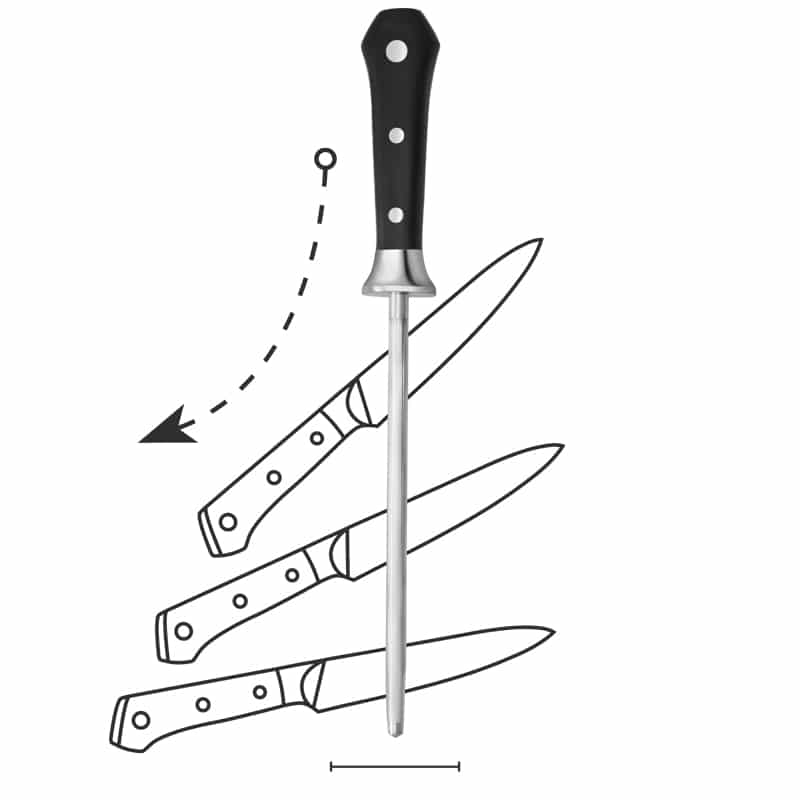SHARPENING YOUR KNIVES
HOW TO TELL IF YOUR KNIVES ARE SHARP ENOUGH
Put the blade to the paper test - even the best knives will dull over time with regular use.
To determine if your knife needs sharpening, hold a folded, but not creased, a sheet of paper by one end.
Lay the blade against the top edge at an angle and slice outward.If the knife fails to slice cleanly, try honing it.If it still fails, it needs sharpening.

HONING VS SHARPENING
HONING
A honing steel basically pushes the edge of the knife back to the center and straightens it. It corrects the edge without shaving off much, if any, of the blade’s material. Honing doesn’t actually sharpen the knife, but if done properly, the knife will seem sharper because the blade is now in, the proper position. Honing should be done often–some even hone before each use.
SHARPENING
Sharpening is a process where bits of the blade is ground away, shaved to produce a new sharp edge. Use either a waterstone, whetstone or electric knife sharpener to sharpen your knife a few times a year depending on usage.
ELECTRIC KNIFE SHARPNERS
With electric sharpeners, the abrasives are on motorized wheels that spin against the blade. Always follow the manufacturer’s instructions. In general: Turn on the sharpener, hold your knife securely but lightly (no need to press down hard; the machine does the work for you), and pull the blade through the desired slots slowly and smoothly. Alternate sides for sharpening both sides of your blade.
MANUAL KNIFE SHARPNERS
Abrasive edges are on nonmotorized wheels, fashioned into a V-shaped chamber. In general, the blade is pulled through the chamber with even pressure to remove metal.
THREE STEPS TO HONING YOUR KNIFE
STEP 1
To use a steel, hold it vertically with the tip held firmly on a counter. Place the heel of the blade against the top of the steel and pointing the knife slightly upward. Hold the blade at a 15-20° angle away from the steel.

STEP 2
Maintaining light pressure and the 15-degree angle, slide the blade down the length of the steel in a sweeping motion, pulling the knife toward your body so that the middle of the blade is in contact with the middle of the steel.

STEP 3
Finish the motion by passing the tip of the blade over the bottom of the steel. Repeat this motion on the other side of the blade. Four or five strokes on each side of the blade (a total of eight to ten alternating passes) should realign the edge.

WHETSTONE SHARPENING
FOLLOW THE STEPS BELOW TO SHARPEN YOUR KNIFE WITH A WHETSTONE.
Soak the whetstone in water between five and ten minutes. The stone has absorbed the optimum amount of water when no air bubbles appear.
Apply water whilst sharpening, this combines with small particles released from the stone to form an abrasive substance, allowing sharpening to take place.
Placing the stone on a slip-resistant base, (our whetstone collect pan). Start using the coarse grit of the stone.
Maintaining an angle of 15-20°, move the blade back and forth—towards and away from the body, across the entire stone using light pressure.

Starting at the tip, pull the blade over the stone through to the middle and down to the base of the blade. After a short time, a fine edge will have developed.
Turn the knife over and repeat this process several times as necessary.
To finish, pull the blade twice at an angle to the cutting edge to remove the last burrs. Your knife should now be really sharp.
Rinse the knives carefully in hot water. Rinse the whetstone and clean away any grinding residue.

